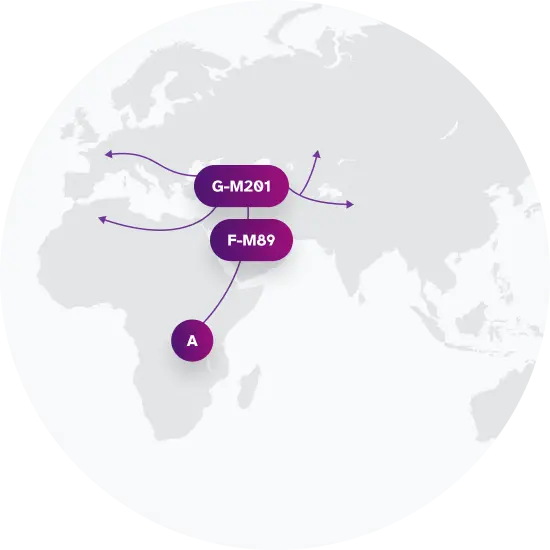Haplogroup G-M406
What is Paternal Haplogroup G-M406?
Haplogroup G-M406, also known as Haplogroup G-M201 (Y Chromosome Consortium long-form label), is a genealogical group of lineages defined by unique genetic markers present on the Y-chromosome. Your paternal haplogroup, or that of your father if you do not have a Y-chromosome, paints a picture of your ancient origins and the migrations of your ancestors. Although your paternal haplogroup reflects just one of your many ancestral lineages, it carries information about that lineage over tens of thousands of years.
Haplogroup G-M406 is descended from haplogroup G-M201. Among 23andMe research participants, haplogroup G-M406 is commonly found among populations in the United Kingdom and Ireland.
It's important to note that your haplogroup doesn't define your current ethnic identity; rather, it provides an insight into your deep ancestry on the paternal side.
 Paternal Haplogroup Origins G-M201
Paternal Haplogroup Origins G-M201Top Surnames with Haplogroup G-M406
For surnames with sufficient representation in the data, these percentages represent the frequency with which each surname is found in individuals exhibiting this genetic marker.
Haplogroup G-M406 is linked to Ötzi the Iceman
Ötzi the Iceman was discovered in 1991, protruding from a snow-bank high in the Alps near the Austrian-Italian border. His 5,300-year-old remains turned out to be so well preserved that researchers were able to construct a detailed account of his life and death. Chemical analysis of Ötzi's teeth indicates he came from the Italian side of the Alps. He had suffered during the year before his death with whipworm, a stomach parasite that was found in his digestive tract. Yet he was fit enough to climb 6,500 feet in elevation during the day or two before he met his end in a rocky alpine hollow. Ötzi apparently was murdered, struck by a stone arrow point that was found lodged in his left shoulder. The twisted position of his body indicates that the murderer, or one of his accomplices, pulled the arrow's shaft out of Ötzi's prone body.Yet whoever killed Ötzi did not take the valuable and finely wrought copper axe that he carried with him — an indicator that at the age of 45, the Ice Man may have been a figure of some importance in his community. Recently, scientists who were able to extract DNA from Ötzi's remains discovered that he belonged to a paternal lineage that stems from haplogroup G-M201. Today, Ötzi's lineage reaches its highest levels in Sardinia and Corsica, and was once common among early European farmers.

